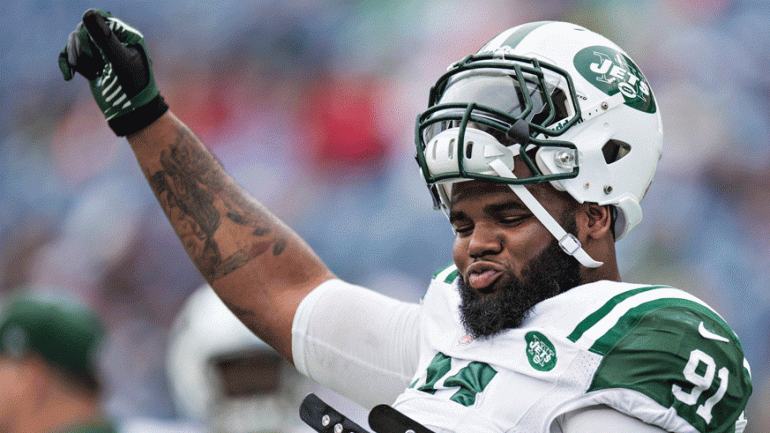Rumors have recently been circulating that the Seahawks might consider making a move to increase their interior pass rush. The rumors stem from NFL reporter Mike Garafolo, who suggested that Seattle might be making some final tweaks to their roster. Earlier this August it was revealed that General Manager John Schneider had approached the Jets about a potential trade for star defensive tackle Sheldon Richardson. Apparently John asked Sheldon to take a paycut but Richardson declined.
With Malik McDowell sidelined from an ATV injury, the Seahawks might look to make a move to increase their inside pass rush. I’m not going to spend time trying to convince you that they should or should not make a move — but rather just present the financial realities of such a move. Before the Justin Britt extension, the Seahawks were dealing with about $3.5-4.5M in true cap space (*true* cap space simply includes accounting for injured reserve, practice squad, and any potential dead money from future cuts).
I have gotten my hands on the full contract extension yet, but a Britt extension will absolutely decrease Seattle’s cap space. It’s safe to assume that Seattle might have around $1-2M cap space, maybe even less, after the Britt extension. Clearly that’s not enough money to afford Richardson, as he carries an $8M cap hit in 2017 (and is a free agent afterwards). If Seattle wants to make a move for Sheldon, here’s several levers they could pull to make it work:
Option #1
Restructure a contract. The Cowboys are famous for this. Seattle could convert a player’s 2017 base salary into a signing bonus, which would equally prorate the cap effects over the life of the contract. Players love when teams do this because that base salary becomes fully guaranteed, as a signing bonus is paid in full to the player immediately. Teams like to do this because it equally divides and spreads the signing bonus over the life of the contract, avoiding one big cap hit in a single year. The Seahawks could pull this level with several core players — Wilson, Sherman, Earl, and others (basically anyone with a high base salary).
Overall, this is probably a bad idea. This cap maneuver leverages future years for immediate relief. However, it would open up enough space for Seattle to add Sheldon.
Option #2
Include a player in a trade. I’m not saying Seattle should do this at all — but they absolutely could offload some salary to offset the impact of a Sheldon trade. Trading Jimmy Graham would open up $8M in cap space. Trading Lane would open up $5M in cap space ($1.25M dead $$ in 2017 and $2.5M dead $$ in 2018), and trading Kearse would only open up an additional $2.2M in cap space (a move like this would initiate a $1.8M dead money hit in both 2017 and 2018).
In a post June 1st designated cut or trade, the dead money is split into two years. Dead money is simply the signing bonus proration from future years. In a trade situation, the team receiving the new player is not on the hook for the signing bonus, as the original team already paid it out (remember a signing bonus is paid 100% up front to a player — but spread over the life of a contract for cap alleviation purposes).
Thus, any team that received Kearse/Lane/Graham or a similar player would only be on the hook for their base salary, plus any workout or roster bonuses. Sheldon doesn’t have a singing bonus in his 5th year option — it is simply a 100%, fully guaranteed base salary of $8.06M. This is why his cap hit would not change in a trade to Seattle (assuming he doesn’t take a pay cut). If you traded Kearse or Lane, since Seattle is the original team, they would incur all dead money charges from the prorated signing bonus.
Unless you want to move a core, elite player (which I don’t think they should do), Seattle’s options are pretty limited.
Option #3
Cut a player or two. Since it’s August 18th, any players cut would receive a post-June 1st designation, which would prorate any dead money cap hits over two years. The likely candidates are Kearse and Rubin — cutting either Kearse or Rubin would each open up $2.2M in cap space. Seattle could pull both of those levers, opening up about $4M in cap space. If Sheldon didn’t accept a paycut, it still likely wouldn’t be enough.
Option #4
Ask Sheldon to take another pay cut. 😉
Conclusion:
If Seattle wants to acquire Sheldon Richardson, they can do it. However, it would likely require a personnel move in combination with a draft pick. The levers listed above are several tools available at the Seahawks’ disposal. Of course, if Seattle wanted to pursue a cheaper interior pass rusher (like on a rookie deal), much less maneuvering would be required from a cap perspective.
Keep tweakin, John.
